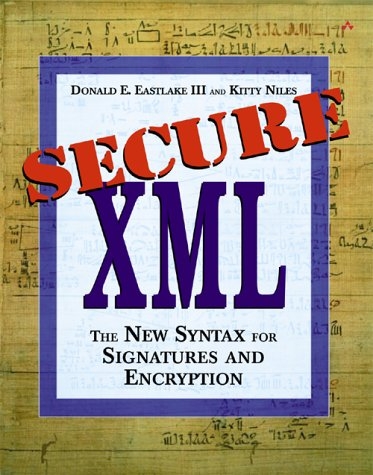
Secure XML
Addison Wesley (Verlag)
978-0-201-75605-0 (ISBN)
- Titel ist leider vergriffen;
keine Neuauflage - Artikel merken
As XML is more broadly used in both web sites and business applications, the need to insure security of XML based applications grows. Most books on XML have at best a chapter devoted to security issues, and there is only one other book currently on the market devoted exclusively to XML Security. This book will show developers all they need to know about how to use XML Digital Signatures to protect the integrity and authenticity of data, and how to use XML Encryption to control its confidentiality. The lead author is at the center of the IETF and W3C working groups formalizing the standards, so there is no one better qualified to write about them. The book will also appeal to networking/security professionals who need to start dealing with the impact of XML on network security.
Donald E. Eastlake III, is the co-chairman of the joint IETF/W3C XML Digital Signature working group, a member of the W3C Encryption and W3C XML Key Management System working groups, and co-author of the XML Digital Signature, XML Encryption, and XML Exclusive Canonicalization standards. He has been deeply involved in network and financial transaction security for many years with IBM, CyberCash, and Digital Equipment Corporation, and is now at Motorola as a Distinguished Member of Technical Staff. He was the principal author of the current IETF Domain Name System security standard and is chairman of the e-Commerce oriented IETF TRADE working group. He has four patents. Earlier efforts in his three decades of work with computer technology include contributions to the Greenblatt Chess Program at MIT, the first computer program to plan chess in tournament competition and be granted a chess rating, and project management of the Data Computer at Computer Corporation of America, the first general purpose terabit data management system on the Internet. Kitty Niles is a freelance technical writer. She was previously a technical writer and online help designer and developer at Digital Equipment Corporation and Process Software Corporation. Her more than two decades of involvement with computer technology have included numerous Digital and Society of Technical Communications documentation awards. Her background includes paleobotany research, medical and environmental research, teaching, and technical illustrating. She is a member of the New York Academy of Sciences (NYAS), the HTML Writers Guild, the Society of Technical Communications, and assorted environmental and conservation groups. 0201756056AB05292002
Preface.
Notations.
Acknowledgments.
I. INTRODUCTION.
1. XML and Security.
XML.
Origins of XML.
XML Goals.
Advantages and Disadvantages of XML.
Uses of XML.
The Need for Secure XML.
Status of XML Security Standardization.
Work in Progress.
2. Digital Cryptography Basics.
Message Digests.
Message Authentication Codes.
Secret or Symmetric Key Ciphers.
Public or Asymmetric Key Ciphers.
Asymmetric Keys and Authentication.
Digital Signatures.
Certificates.
Enveloped Encryption.
Canonicalization.
Randomness.
Other Facets of Security.
Cryptography: A Subtle Art.
II. XML BASICS.
3. The Extensible Markup Language.
Related Standards and Recommendations.
XML Documents.
XML Parsing Process.
Well-Formed Documents.
Valid XML Documents.
XML Document Structure.
XML Document Logical Structure.
The XML Declaration.
Elements.
Attributes.
Special Attributes xml:space and xml:lang.
CDATA Sections.
Comments.
Character Sets and Encoding.
Processing Instructions.
XML Namespaces.
Namespace Declarations.
Using Qualified Names.
Namespace Guidelines.
XML Document Physical Structure.
General and Parameter Entities.
Internal and External Entities.
Entity References.
XML and Stylesheets.
Cascading Style Sheets.
Extensible Stylesheet Language.
XSL Versus CSS.
4. XML Document Type Definitions.
Introduction to DTDs.
Document Type Declarations.
Document Type Declaration Format.
Document Type Declaration Guidelines.
Conditional Sections.
Element Type Declarations.
Element Structures.
Element Content Models.
Frequency Indicators.
Multiple Elements Within an Element.
General Guidelines for Element Type Declarations.
Defining Attributes in DTDs.
Attribute Types.
Attribute Defaults.
Entity Reference Declarations.
Internal General Entity Reference Declarations.
Parameter Entity Reference Declarations.
Notation Declarations.
5. XML Schema.
Overview.
Types.
simpleType.
complexType.
Elements and Attributes.
Namespaces.
Miscellaneous Aspects of Schemas.
Parts Not Covered.
6. XPath: A Basic Building Block.
Introduction to XPath.
Data Model.
Root Nodes.
Element Nodes.
Attribute Nodes.
Namespace Nodes.
Text Nodes.
Processing Instruction Nodes.
Comment Nodes.
Location Paths.
Location Steps.
Axes.
Node Tests.
Predicates.
Abbreviated Notation.
Expressions.
Function Calls.
Operators.
Function Library.
Node-Set Functions.
String Functions.
Boolean Functions.
Number Functions. 7. URIs, xml:base, and XPointer.
URIs.
URI Syntax.
Relative URIs.
URI References and Fragment Specifiers.
URI Encoding.
xml:base.
XPointer.
Forms of XPointer.
The XPath Extensions.
XPointer Functions.
8. SOAP.
Introduction to SOAP.
Features Included and Excluded.
Relation of SOAP to XML.
Basic SOAP Namespaces.
SOAP Envelope, Message Exchange, and Processing Model.
SOAP Messages.
SOAP Actors.
SOAP Processing.
SOAP Faults.
SOAP Envelope and Fault Schemas.
SOAP Encoding.
The encodingStyle Attribute.
The http://www.w3.org/2001/12/soap-encoding Encoding.
SOAP Transport Binding and HTTP.
Transport Message Exchange Patterns.
The SOAP HTTP Binding.
SOAP Remote Procedure Call.
SOAP HTTP Remote Procedure Call.
Remote Procedure Call Faults.
Remote Procedure Call Schema.
Mapping Application Parameter Names into XML.
III. CANONICALIZATION AND AUTHENTICATION.
9. XML Canonicalization: The Key to Robustness.
Canonicalization-Essential for Signatures Over XML.
Some Simple Aspects of XML Canonicalization.
The Problems with XML White Space.
The Problems with XML Namespaces.
Canonicalization Is Required for XML Data.
Canonical XML and XML Encryption.
Transformative Summary.
Input/Read Rules.
Output/Print Rules.
Inherited Attribute and Namespace Declaration Rules.
The XML Canonicalization Data Model.
Node-Set.
Document Order.
Alphabetic Order for Namespaces and Attributes.
Formal Generative Specification.
The Root Node.
Element Nodes.
Attribute Nodes.
Namespace Nodes.
Text Nodes.
Processing Instruction Nodes.
Comment Nodes.
Limitations of XML Canonicalization.
Application Equivalences.
Character Normalization.
Operational Nonequivalence.
Exclusion/Inclusion of Ancestor Namespace Declarations and xml Namespace Attributes.
10. XML Signatures and Authentication.
Introduction to XML Digital Signatures.
XML Signature Syntax.
The Signature Element.
The SignedInfo Element.
The Reference Element.
The SignatureValue Element.
The KeyInfo Element.
The Object Element.
The Manifest Element.
The SignatureProperties Element.
Comments and Processing Instructions.
XML Signature Examples.
Simple Protocol Example.
Simple Document Example.
More Complex Protocol Example.
More Complex Form Example.
Transforms and the Use of XPath.
The “XPath” Data Model.
Dereferencing the URI.
The Data Pipeline.
Transforms Element Syntax.
Processing Rules.
Signature Generation.
Signature Verification.
Security of Signatures.
Transforms.
Check the Signature Security Model.
Signature Strength.
Algorithms and Executable Content Caution.
11. Profiling XMLDSIG for Applications.
P3P XMLDSIG.
Linkage of XMLDSIG to P3P Semantics.
Specific Assurance Syntax.
P3P XMLDSIG Use.
Limitations.
SOAP XMLDSIG.
Processing Rules.
SOAP Signature Example.
12. ETSI “Advanced” XML Signatures.
Levels of XAdES Signature.
XAdES.
XAdES-T.
XAdES-C.
XAdES-X.
XAdES-XL.
XAdES-A.
XAdES Signature Syntax Basics.
Qualifying and Qualifying Reference Properties.
Signed and Unsigned Properties.
Basic Elements.
XAdES Signature Elements Syntax.
The SigningTime Element.
The SigningCertificate Element.
The SignaturePolicyIdentifier Element.
The CounterSignature Element.
The DataObjectFormat Element.
The CommitmentTypeIndication Element.
The SignatureProductionPlace Element.
The SignerRole Element.
The AllDataObjectsTimeStamp and IndividualDataObjectsTimeStamp Element.
Validation Data Syntax.
The SignatureTimeStamp Element.
The CompleteCertificateRefs Element.
The CompleteRevocationRefs Element.
The SigAndRefsTimeStamp Element.
The RefsOnlyTimestamp Element.
The CertificateValues Property Element.
The RevocationValues Property Element.
The XAdESArchiveTimestamp Element.
IV. KEYING.
13. The KeyInfo Element.
The KeyValue Element.
The DSAKeyValue Element.
The RSAKeyValue Element.
The DHKeyValue Element.
The EncryptedKey Element.
The RetrievalMethod Element.
The AgreementMethod Element.
The KeyName Element.
The X509Data Element.
Distinguished Name Encoding.
X509Data Syntax.
PKCS7signedData Element.
OCSP Tokens.
The PGPData Element.
The SPKIData Element.
The MgmtData Element.
14. XKMS: XML Key Management.
The Key Information Service.
X-KISS Services.
Locate Service.
Validate Service.
XKMS Common Data Elements.
The Key Registration Service.
X-KRSS Service.
X-KRSS Register Messages.
Bulk Registration Services.
XKMS Cryptographic Algorithms.
Shared Secret Data.
Registration of User-Generated Keys.
Registration of Server-Generated Keys.
Security Considerations.
V. ENCRYPTION.
15. XML Encryption.
Introduction to XML Encryption.
Why Another Encryption Syntax?
Encryption Granularity.
Enveloping and Detached Encryption.
XML Encryption Syntax.
The EncryptedType.
The CipherData Element.
The EncryptionProperties Element.
The EncryptedData Element.
The EncryptedKey Element.
The ReferenceList Element.
Extensions to the ds:KeyInfo Element.
Encryption Examples.
Encrypting XML Elements.
Encrypting XML Element Content.
Encrypting Arbitrary Data.
Super-Encryption.
Referenced EncryptedKey.
Processing Flow.
Encryption.
Decryption.
XML Encryption.
Encryption Security Considerations.
Combining XMLDSIG and XML Encryption.
Information Revealed.
Care with Algorithms and Expressions.
16. Combining Encryption and Signature.
General Considerations.
Encryption of Signed Data and Signature.
Encryption of Signed Data But Not Signature.
Signing Encrypted Data.
The Decryption Transform.
Introduction to the Decryption Transform.
Decryption Transform Syntax.
Decryption Transform Processing.
Decryption Transform Limitations.
VI. ALGORITHMS 381 17. Overview of Algorithms.
Algorithm Syntax.
Algorithmic Roles.
AgreementMethod.
CanonicalizationMethod.
DigestMethod.
EncryptionMethod.
SignatureMethod.
Transform.
18. Cryptographic Algorithms.
Message Digests.
MD5.
SHA-1.
Additional SHA Versions.
RIPEMD-160.
Key Agreement Algorithms.
Diffie-Hellman Key Agreement.
Message Authentication Codes.
HMAC SHA-1.
Additional HMAC Variations.
Signature Algorithms.
DSA.
RSA-SHA1.
Additional RSA Variations.
Block Encryption Algorithms.
Triple DES.
AES.
Stream Encryption Algorithms.
ARCFOUR.
Key Transport Algorithms.
RSA Version 1.5.
RSA-OAEP.
Symmetric Key Wrap Algorithms.
CMS Key Checksum.
Triple DES Key Wrap.
AES Key Wrap.
19. Non-cryptographic Algorithms.
Canonicalization Algorithms.
Canonical XML.
Exclusive XML Canonicalization.
Minimal Canonicalization.
Transformation Algorithms.
Canonicalization.
Base-64 Decoding.
XPath Filtering.
Enveloped Signature Transform.
XSLT Transform.
XPointer.
XML Schema Validation.
Decryption Transform.
APPENDIXES.
Appendix A XML Security Implementations.
Apache.
Baltimore Technologies.
Capslock.
Done Information.
DSTC.
Entrust.
Fujitsu.
GapXse.
HP Web Services.
IAIK.
IBM.
Infomosaic.
JDSS II.
Mather.
Microsoft.
NEC.
Phaos Technology.
Poupou.
RSA Security.
Siggen.
Verisign.
W3C.
WebSig.
Wedgetail.
XML Sec.
Appendix B The W3C and W3C Documents.
Access to W3C Documents.
W3C Document Status.
W3C Document Format.
W3C Document Disclaimer.
W3C Software Disclaimer.
Appendix C The IETF and IETF Documents.
RFC Status.
Access to RFCs.
RFC Format.
Appendix D The NIST and NIST Documents.
Access to NIST FIPS Documents.
Status of NIST Documents.
Format of FIPS.
Appendix E The Paper and Protocol Points of View.
The Basic Points of View.
Questions of Meaning.
Core Meaning.
Adjunct Meaning.
Processing Models.
Amount of Processing.
Granularity of Processing.
Extensibility of Processing.
Security and Canonicalization.
Canonicalization.
Digital Authentication.
Canonicalization and Digital Authentication.
Encryption.
Unique Internal Labels.
Examples.
Resolution of the Points of View. Appendix F SOAP Encoding Schema.
References and Acronyms.
Index. 0201756056T07152002
| Erscheint lt. Verlag | 19.7.2002 |
|---|---|
| Mitarbeit |
Herausgeber (Serie): Marcy Barnes |
| Verlagsort | Harlow |
| Sprache | englisch |
| Themenwelt | Informatik ► Netzwerke ► Sicherheit / Firewall |
| Informatik ► Theorie / Studium ► Kryptologie | |
| Mathematik / Informatik ► Informatik ► Web / Internet | |
| ISBN-10 | 0-201-75605-6 / 0201756056 |
| ISBN-13 | 978-0-201-75605-0 / 9780201756050 |
| Zustand | Neuware |
| Haben Sie eine Frage zum Produkt? |
aus dem Bereich


